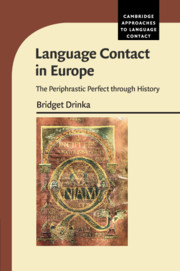Book contents
- Frontmatter
- Contents
- Series Editor's Foreword
- Acknowledgments
- Abbreviations, Based on the Leipzig Glossing Rules
- 1 Language Contact in Europe: The Periphrastic Perfect through History
- 2 Languages in Contact, Areal Linguistics, and the Perfect
- 3 The Perfect as a Category
- 4 Sources of the Perfect in Indo- European
- 5 The Periphrastic Perfect in Greek
- 6 The Periphrastic Perfect in Latin
- 7 The Charlemagne Sprachbund and the Periphrastic Perfects
- 8 The Core and Peripheral Features of the Romance Languages
- 9 The Early Development of the Perfect in the Germanic Languages
- 10 The Semantic Shift of Anterior to Preterite
- 11 The Balkan Perfects: Grammaticalization and Contact
- 12 Byzantium, Orthodoxy, and Old Church Slavonic
- 13 The l- perfect in North Slavic
- 14 Updating the Notion of Sprachbund: New Resultatives and the Circum- Baltic “Stratifi ed Convergence Zone”
- 15 The have Resultative in North Slavic and Baltic
- 16 Conclusions
- Notes
- Bibliography
- Index
12 - Byzantium, Orthodoxy, and Old Church Slavonic
Published online by Cambridge University Press: 23 February 2017
- Frontmatter
- Contents
- Series Editor's Foreword
- Acknowledgments
- Abbreviations, Based on the Leipzig Glossing Rules
- 1 Language Contact in Europe: The Periphrastic Perfect through History
- 2 Languages in Contact, Areal Linguistics, and the Perfect
- 3 The Perfect as a Category
- 4 Sources of the Perfect in Indo- European
- 5 The Periphrastic Perfect in Greek
- 6 The Periphrastic Perfect in Latin
- 7 The Charlemagne Sprachbund and the Periphrastic Perfects
- 8 The Core and Peripheral Features of the Romance Languages
- 9 The Early Development of the Perfect in the Germanic Languages
- 10 The Semantic Shift of Anterior to Preterite
- 11 The Balkan Perfects: Grammaticalization and Contact
- 12 Byzantium, Orthodoxy, and Old Church Slavonic
- 13 The l- perfect in North Slavic
- 14 Updating the Notion of Sprachbund: New Resultatives and the Circum- Baltic “Stratifi ed Convergence Zone”
- 15 The have Resultative in North Slavic and Baltic
- 16 Conclusions
- Notes
- Bibliography
- Index
Summary
Introduction
In the previous chapter, our focus on the historical interactions of the Balkan languages, including the South Slavic varieties, revealed the preeminence of Greek in that area and the essential role language contact played in the history of the perfects there. In the present chapter, we focus more particularly on the influential status of Byzantine Greek as emblem of the Byzantine Empire and the Greek Orthodox Church and on the “roofing” effect that this influence had on the perfects of Old Church Slavonic. We construct a chronologization reminiscent of that formulated by Maslov (1988: 70–85) in his classic work on the typology of the resultative, the perfect, and aspect. Maslov distinguishes three layers in the development of resultatives and perfects in the history of Slavic:
1) the Indo-European layer, with its synthetic stative perfect
2) the expansion of the perfect through the introduction of analyticity in such forms as the l-perfect, and
3) the creation of new possessive resultatives and perfects built on past passive participles in -n/t- and of non-possessive structures such as that built on the gerund in –(v)ši.
Having discussed the Indo-European perfect in detail in Chapter 4, we begin here with an examination of the second layer, and continue this discussion into the next chapter; the third layer will be examined in Chapters 14–15. Throughout this chapter and the next three, we will attempt to sort out the possible motivations for these developments and their complex interactions.
Slavia Orthodoxa and Slavia Romana
In his study of Church Slavonic and the impact that confessional allegiance had on the development of the Slavic languages, Riccardo Picchio (1980: 22) coined the terms “Slavia Orthodoxa” and “Slavia Romana” to refer to the cultural and linguistic divide that existed between those Slavic lands that adhered originally to Greek Orthodoxy and those that practiced Roman Catholicism, respectively. Slavia Orthodoxa, comprising modern-day Serbia, Bulgaria, Macedonia, Russia, Ukraine, and Belarus, remained historically under the influence of Byzantium and the Greek Orthodox Church; Slavia Romana, consisting of present-day Poland, Czechia, Slovakia, Slovenia, Croatia, and Lusatia in Germany, was historically Roman Catholic, and, later, also Protestant. One sign of the contrast between east and west is the use of the Cyrillic and, historically, Glagolitic alphabets in the east and the Roman alphabet in the west – iconic symbols of adherence to different cultural norms and scholarly traditions.
- Type
- Chapter
- Information
- Language Contact in EuropeThe Periphrastic Perfect through History, pp. 288 - 313Publisher: Cambridge University PressPrint publication year: 2017

